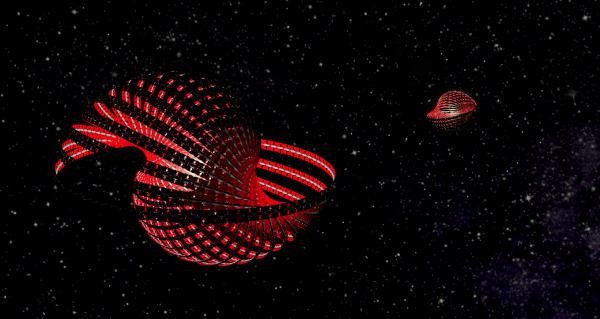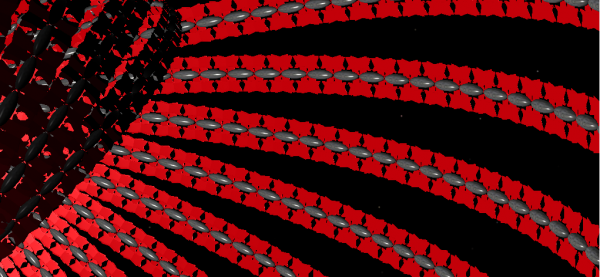BY LETTER
Black Acropolis
History > -13.7Gy to -7000 AT: Preterragen Era
Galactography > Systems and Worlds > Systems & Worlds A - B
Sophonts > Xenosophonts
Galactography > Systems and Worlds > Systems & Worlds A - B
Sophonts > Xenosophonts
Alien Dyson Swarm | |
 Image from Steve Bowers | |
| The twin dyson swarms of the Black Acropolis are arranged in a 'snailshell' configuration. The two outermost bands of each swarm are linked by minor habitats travelling in a 'figure-of-eight' orbit | |
Location: RA 18h 45 Dec 9° 48
Distance: 1530 ly
The Black Acropolis is an ancient Dyson swarm, which appears to have been first built 312 million years ago by the vanished Tkzeph empire.
Over the next 296 million standard years the empty Tkzeph structure became derelict as the orbiting elements collided with each other, resulting in a Kessler Syndrome scenario.
16 million years ago the swarm was rebuilt by another species, generally known as the Black Acropolis civilisation. The original world of this species has not been identified, and no other colonies have been found. One theory is that this species actually evolved in the Acropolis from waste matter or maintenance biotech left behind by the Tzkeph. One mystery is why biotech of this sort has survived here, when all other Tzkeph technology vanished at the same time as the rest of its civilisation. This may be explained by the fact that one of the two stars is a flare star, so the biotech there may have been particularly resistant to damage.
The Black Acropolis Civilisation itself was apparently eradicated by the enigmatic Dawn Hunters 14.8 million years ago, if contemporaneous Muuh legends are trustworthy.
1.2 million years ago a third civilisation of Xenosophonts arrived at the Acropolis and started to colonise the biospheres, which were empty at that time. This civilisation created diverse clades of sophont and semi-sophont creatures that have become known as the Ultimates, because of their own self-identification as "That/Us (which) cannot be surpassed". The civilisation which created the Ultimates itself has left no other trace, and in fact may have arrived in a long-distance exploration probe which targeted the Acropolis from far outside the Terragen Sphere.
Structure
 Image from Steve Bowers | |
| There are 4320 habitats of varying sizes in the twin dyson swarms; they are all linked in a series of continuous bands of solar collectors, which distribute the collected energy evenly in each band. There are 36 bands in total. | |
The Acropolis itself consists of a large number of huge black biospheres arranged into two Dyson Swarms orbiting the twin stars JD 9985510A+B. Some are ruined or depressurised, but the remainder contain a variety of environments, including a number of Earth-like regimes. Continuous bands of solar power collectors of various radii orbit the stars, at various radii and inclinations. The habitats are imbedded in the band but rotate independently to create artificial gravity. The conditions in these habitats range from very cold to near the boiling point of water, at a wide range of pressures. Each cylinder rotates to give a specific level of artificial gravity, from 0.04 gees to 6.7 gees. Many of these environments are lifeless, despite being intact; others have been colonised by diverse phyles of Ultimates. A large number of the empty habitats have been colonised by various Terragen clades, and some of these are densely populated. Others are still largely uninhabited.
The Black Acropolis, 1530 ly from Sol in Ophiuchus, was detected in the Interplanetary Age by telescopic observation and is the closest alien Dyson Swarm to Earth. An expedition of relativistic space adapted human colonists reached the Black Acropolis system in 4723, joining a clade of dolphin colonists who had arrived 22 years earlier. In the following centuries it was colonised by various other clades. After several decades of conflict between each other and with the Ultimates, they formed the hybrid Gerkletoss civilisation in the 4900s.
The first explorers imagined that the inhabitants of this structure would be the same civilisation that built it; but detailed examination uncovered its venerable past. Evidence of the original Tkzeph structure is preserved inside re-used rocks and boulders inside the current habitats.
Timeline
312 million standard years BT - The Tkzeph build the original Dyson swarm, then mysteriously vanish, and the swarm falls into ruin.16 million years BT - The Black Acropolis Civilisation emerges, possibly having evolved from Tzkeph biotech, and build the existing structure from the debris.
14.8 million years BT - The Black Acropolis Civilisation is wiped out, apparently by the enigmatic Dawn Hunters.
1.2 million years ago - The Ultimates are introduced into several of the biospheres by another enigmatic civilisation: after a short period of expansion they settle into a static society.
35,000 BT - The "Great Reformation", an attempt by the Ultimates of the Shining Path Morph to revive the morphospecies, institutes a brief renaissance, and a period of colonisation ("The Seeding") of nearby worlds.
20,400 BT - The last of the Ultimate Colonies ("Fruits") disappear. In the sheltered biospheres of the Black Acropolis the descendants of the Shining Path Morph have long since ossified into a self-cocooned equilibrium state.
10,000 BT - The cocooned Ultimates are slowly diminishing in numbers.
4701 AT - A clade of heterodox dolphin colonists from Hwii arrive at the Black Acropolis habitats, fleeing the rigidity and conservatism of Okeanism.
4723 - They are joined by an expedition of Space Adapted Humans. The Dolphins and SAH contact the Ultimates. The Ultimates are fascinated by, but also wary of, the AIs; being biologicals they have never developed sentient nonorganic aioids. Ultimates schism into two factions, one pro-contact and the other isolationist and cocoonist. The pro-contacts see this a great opportunity for the revival of the race. But even the pro-contact, neo-reformationist and neo-expansionist Ultimates see the Terragen humans as crude revolting barbarians. An uneasy relationship develops between the three factions.
4780 - The so-called Terran-Ultimate Discord, the most serious of the "cold wars" between Terragens and Ultimates, is resolved peacefully after long mediation by both sides.
4806 - Election of the radical reactionary baseline and anthropist philosopher, demagogue, and leader Jonn Sarhvant causes a schism among the near-baselines. Those that are more sympathetic to the dolphs, Ultimates, and SynBios secede from the main body to form Universal Nation.
4809 - The "Acropolis Accord" between the space adapted humans and the neodolphins panic the anthropist baseline humans.
4813 - Under Sarhvant the Noble Human Army attacks the alliance of space adapted humans and dolphs for ownership of the coveted Delta Six Level A Biospheres - a brief but bloody episode which leaves heavy casualties on both sides. The Universal Nation lends support to the dolphs and spacers. Further disquiet among the Ultimates at this show of Terragen violence. Tensions escalate.
4815 - The so-called Habitat War. Sarhvant's faction of expansionist near-baselines with the help of their AIs and nanotech initiate a well-planned blitzkrieg against the Ultimate-spacer-neodolphin-universalist alliance and gain ownership of the whole of Sectors Delta and Epsilon. They are eventually stopped by Ultimate bionanites, and lose many of their territorial gains.
4816 - A coup overthrows Sarhvant, who is placed under house arrest. Sarhvantism is declared illegal in the near-baseline habitats.
4821 - The Cold Peace.
4845 - The rise to power and public office of the great neodolphin pacifist and statesbeing Wide Blue Waters (who centuries later was to be mythologised as the most recent avatar of the Great One Cosmic Ocean of later Tipusa religion) does much to lay the groundwork for peaceful relations between the clades.
4848- Feeling isolated and keen to impress the other clades, the near-baselines drag the elderly Jonn Sarhvant out of house arrest and try him under the laws of the New Copernicus Convention for crimes against mindkind.
4852 - The New Thaw
4855 - Universal Nation expands to include the majority of near-baselines.
4868 - The remaining anthropist baselines and Sarhvant sympathisers, fearing persecution, leave in a relativistic ship for the Sagittarius arm. They are never heard from again.
4886 - Fresh from his second rejuve treatment, Wide Blue Waters pushes through the the Lambda 2 Convention, ratified by representatives of all the species. Despite some territorial grumblings, relationships continue to improve between the clades.
4920 - Elements of The SynBios, a synclade of human, dolphin, and neo-reformist Ultimate that developed in the early decades of the Glorious Communion in the Black Acropolis habitats, set forth to colonise further star systems.
4937 - Signing of the Gerkletoss Accord.
5768 - The Gerkletoss system is connected to the Wormhole Nexus.
6420 - The AI part of the Gerkletoss civilisation rebels against the constraints on their development, beginning fast autoevolution. Massive use of exotic matter and spacetime engineering leaves the region extremely dangerous. A number of refugees flee to nearby star systems in Ultimate-designed generation ships.
8693 - Human and dolphin refugees from the Gerkletoss rebellion/transcendence arrive at Skiiws'nnii and begin the terraforming of that world.
Related Articles
Appears in Topics
Development Notes
Text by Anders Sandberg
with additions by M. Alan Kazlev, Steve Bowers, Todd Drashner, and Mark Ryherd
Initially published on 27 August 2001.
To download the Black Acropolis for Celestia, click this link and download it into Celestia's Extras folder
then follow this CEL link The Black Acropolis
You can download Celestia from here
with additions by M. Alan Kazlev, Steve Bowers, Todd Drashner, and Mark Ryherd
Initially published on 27 August 2001.
To download the Black Acropolis for Celestia, click this link and download it into Celestia's Extras folder
then follow this CEL link The Black Acropolis
You can download Celestia from here






